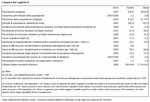8. The figures tell the story
|
Veneto has changed from a region of emigration to a region of immigration. Through the changes seen in migration patterns we can see Veneto moving from a rural economy to becoming a more solid one.
The turning point occurred towards the end of the 1960s: from 1968 on, net migration with other regions began to be positive, followed shortly by positive migration with abroad. About 260,000 Veneto citizens living abroad have kept their Italian citizenship; they live mainly in Europe (46.8%), especially in France, Germany and Belgium, and in Central and South America (39.5%). In the early 1990s, flows from abroad began to grow more quickly, and there has been an acceleration since 2000: today there are about 457,000 foreign residents in Veneto, 9.3% of the population. Romania contributes the largest group of foreign residents (19%), followed by Morocco (12.3%). New people settling in Veneto contribute to a rise in the local population; at the end of 2007 Veneto had a population of 4,832,340, which will probably reach 5 million by 2012. The local population of Veneto move around a lot; they are happy to move house over short or medium distances, mostly within the region, but are not so inclined to move to different regions. Foreign citizens are much more inclined to move around than Italian ones: once they have reached Italy they do not settle down immediately but continue their journey in order to find better living and working conditions. (Chapter 8 in figures) |
|
Data processed by the Statistics Office of Regione Veneto are collective property; reproduction of this material is authorised for non-commercial purposes only, provided the source "Regione Veneto - Regional Statistics System Management" is acknowledged.
English translation by the University of Padova Language Centre.



